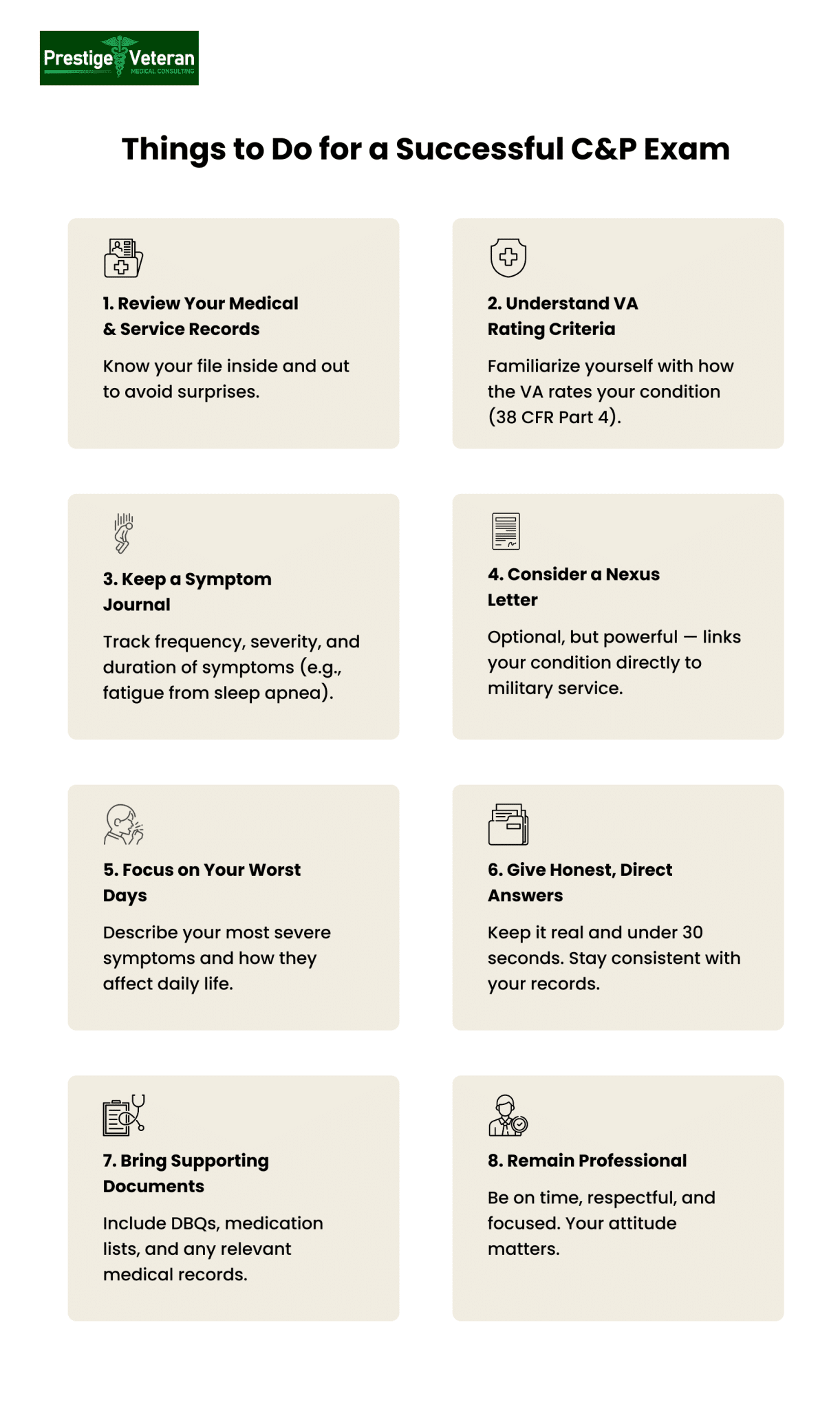Last Updated on 6 August, 2025
Reviewed by: A licensed medical professional and former U.S. military veteran from Prestige Veteran Medical Consulting Services.
For many veterans, the VA Compensation and Pension (C&P) exam can feel like the most stressful step in the VA disability claims process, though it doesn’t have to be. With more than 6 million veterans receiving VA disability compensation as of 2025, preparing for your C&P exam has become an important requirement.
Whether filing for a mental health claim or physical disability, understanding what to do and what to avoid at your C&P exam can lead you towards a successful VA disability claim. Additionally, explore the significance of the Disability Benefits Questionnaire (DBQ) in this detailed guide.
Table of Contents
What is a VA C&P Exam?
A Compensation and Pension (C&P) exam is a medical assessment conducted by the Department of Veterans Affairs (VA) to evaluate the severity of a veteran’s claimed disability and determine its service connection. Not every veteran will need a C&P exam; some cases are processed using the ACE (Acceptable Clinical Evidence) process, which allows the VA to decide based solely on records.
The VA often requests this exam when you file for disability compensation and:
- There isn’t sufficient medical evidence in your claim file to confirm a diagnosis or establish service connection.
- You’re claiming multiple conditions, each requiring separate evaluation to determine severity and impact.
- You’re requesting a review, rating increase, or appealing a decision, and the VA needs updated evidence to reassess your current disability status.
Conducted by a VA provider or a contracted clinician, the C&P exam is not a general check-up, but rather a medical evaluation tailored to your specific claims.
For example, if you’re attending a C&P exam for sciatica, the VA examiner may assess nerve impairment, muscle weakness, reflexes, and radiating leg pain. Their report is sent to the VA to be considered alongside your other medical records and evidence, which then determines your eligibility and monthly compensation.
How the VA Schedules Your Exam
You will usually be notified of the Compensation and Pension exam by mail or phone, either from your VA or a third-party contractor. These exams may take place at VA medical centers, physician clinics, or via telehealth, especially for mental health claims.
The C&P examination itself varies based on the disability, for example,
For physical conditions, the examiner might perform a physical assessment, review past treatments, and evaluate functional limitations.
For mental health conditions like PTSD, the examiner will delve into your symptoms, triggers, and how they impact your mental and emotional well-being.
You can confirm the location of your C&P exam through resources like your local VA medical center, VA.gov, your accredited legal professional, or by checking your appointment notice.
How Much Weight Does a C&P Exam Have in Your VA Disability Claim?
A Compensation & Pension (C&P) exam carries significant weight in your VA disability claim as it evaluates your condition, determines service connection, and assigns a disability rating. During the exam, a VA or contracted examiner reviews your medical records, asks questions on symptoms and life impact, and may perform physical or psychological tests.
This examiner’s report, especially their medical opinion stating it’s “at least as likely as not” your condition is service-connected, can secure you a favorable VA decision. Conversely, if the examiner provides a negative opinion or fails to accurately describe your limitations, it can result in a low rating or denial.
While the VA also reviews service records, private medical evidence, and submitted Disability Benefits Questionnaires (DBQs), the C&P examiner’s report strongly influences the outcome of your claim or appeal.
9 Things to Do for a Successful C&P Exam
Preparation plays an important role in how a VA C&P exam is documented. Firstly, understand the exam’s purpose; if it’s to establish a service connection, be prepared to discuss the in-service event that caused it and the body system involved.
The following steps outline ways veterans often prepare for a VA disability claim examination.

1. Review Your Medical and Service Records
Before the C&P exam, carefully review your VA claim file (C-File). This includes any service treatment records, VA medical records, and private medical documentation you have submitted online, through an accredited representative, or by mail to the VA regional office. Knowing what’s in your file helps you answer questions accurately and address potential discrepancies.
For example, if your records indicate a diagnosis of chronic knee pain, ensure you can discuss how it began during military service, if applicable and its ongoing impact. Review any diagnostic test results or treatment notes to present an accurate picture of your condition.
2. Understand the VA’s Rating Criteria
The VA uses specific criteria to assign a veteran’s disability rating, as found in the Schedule for Rating Disabilities (38 CFR, Part 4). Familiarize yourself with the criteria for your condition if you are interested in understanding the specific rating information for your condition..
3. Keep a Symptom Journal
Documenting your symptoms over time provides a detailed account of how your condition affects you. Include information about frequency, severity, and duration. For example, if you have sleep apnea, list down symptoms in this way:
- Frequency: Record how often you wake up gasping for air (e.g., every night).
- Severity: Note how it leaves you feeling exhausted and causes persistent daytime sleepiness, making it hard to function.
- Duration: Track how long the fatigue lasts (e.g., feeling drained for most of the day).
Keeping a symptom journal like this documents the impact of your condition on your mobility, relationships, work, and sleep, etc.
4. Consider Obtaining a Nexus Letter
A nexus letter or an independent medical opinion from a qualified healthcare professional can support your claim by explicitly linking your condition to your military service. These letters are never required but can provide support in some cases.
This letter aims to serve as medical evidence that explains the connection between your service and your disability. For example, if you’re claiming sciatica as a result of carrying heavy loads during your service, a nexus letter can clarify how those activities directly contributed to your condition, supporting your claim.
5. Plan for the Exam Day
Dress comfortably and arrive 15 minutes early to the Compensation and Pension (C&P) exam location. Bring ID and all relevant documents. If needed, request VA for travel reimbursement. Veterans have the option to request a provider of a specific gender, especially for MST-related claims. Stay calm and focus on clearly communicating your symptoms and experiences.
6. Try Focusing on Your Worst Days
The VA evaluates the impact of your condition based on its most severe manifestations. If your knee pain flares up after standing for extended periods, explain during the C&P exam how this limits your ability to perform household chores or work tasks.
For example, describe “On a bad day, severe knee pain caused me to stumble and fall on the stairs.”
7. Provide Honest and Sharp Answers
Provide truthful and concise answers, ideally under 30 seconds, during your VA C&P exam. Avoid exaggeration or minimizing symptoms.
For example, if you experience severe PTSD symptoms like nightly nightmares and avoidance of crowded places, articulate these specifics instead of generalizing your struggles. Explain how your service-connected disability negatively impacts your work, life, and social functioning. Consistency in your medical records, statements, and behavior is extremely important.
8. Bring Supporting Documentation
Carry relevant medical records, both VA and private, a list of ongoing medications, and any Disability Benefits Questionnaires (DBQs) completed by your private doctor. These materials help support your claim.
9. Remain Professional During the Exam
Being punctual on your C&P exam date may make you seem responsible and sincere. Treat the examiner with respect and stay focused on your symptoms and limitations. A cooperative attitude ensures the focus remains on your condition and claim.
8 Things to Avoid During Your C&P Exam
Knowing what not to say at the C&P exam is as crucial as being prepared. Mistakes or oversights can jeopardize your claim. Here are some considerations:
1. Lying or Exaggerating Symptoms
Misrepresentation can damage your credibility and lead to a denial of your claim. For instance, claiming constant pain when it only occurs occasionally raises red flags. Every C&P examiner is trained to identify malingering (falsification or exaggeration of illness), so it’s wiser to remain honest with your answers and documentation.
2. Minimizing or Downplaying Symptoms
Veterans often downplay symptoms due to pride or fear of being seen as weak. This can result in an inaccurate assessment and potentially a lower disability rating.
For instance, at a C&P exam for anxiety, you can say, “My anxiety makes it hard to leave the house, be around people, or focus on everyday tasks. I face trouble sleeping, and I constantly feel on edge.”
3. Acting Differently from Your Normal Routine
Your behavior is observed from the moment you arrive at the C&P exam. For instance, claiming you cannot bend due to back pain but being seen picking up an item from the floor effortlessly may seem inconsistent. Ensure your behavior is honest to avoid casting doubt on the validity of your condition.
4. Giving Vague Answers
Avoid one-word or vague responses like “I’m fine” or “It’s not too bad.” Instead, consider providing context: “My depression makes it hard to get out of bed most mornings, and I struggle to focus on daily tasks” are common complaints.
Sometimes, the C&P examiner may not be familiar with military terminology or jargon. Hence, focusing only on the medical facts may be beneficial.
5. Arguing with the Examiner
If you disagree with the examiner’s observations of your condition’s severity, stay calm and provide additional context on how it impacts your daily activities, like difficulty standing or lifting objects. A defensive or combative attitude can detract from the focus of the VA C&P exam.
Similarly, if the examiner is uninterested in reviewing new X-ray results, simply mention their importance and focus on answering the questions. If you are working with an accredited legal professional, they may be able to help you navigate a bad experience.
6. Assuming the Examiner Knows Everything
C&P examiners may review your medical records and VA claim details, but assuming they know everything is a mistake. Never rely solely on your file to communicate your symptoms and how they affect your daily life.
Many veterans may provide context with statements that align with their history, like, “I experience panic attacks twice a week that prevent me from leaving the house.” Clearly explaining your challenges, even if they’re documented, helps to ensure the examiner obtains a clear picture of what you are experiencing.
7. Missing the Appointment
Failing to attend your scheduled appointment without rescheduling can delay or deny your benefits claim. If you have filed for multiple disability claims, the VA may request you to appear for multiple Compensation and Pension exams. Contact the VA immediately if you cannot make your scheduled exam.
8. Assuming Chart Reviews are Unfair
The VA may opt for a “chart review”, that is, assessing existing medical records instead of scheduling an in-person C&P exam. While it can feel like your claim is being neglected, chart reviews are sometimes sufficient depending on the claim’s circumstances and severity.
What or Who to Bring to the Exam
Bringing the right items and people to your C&P exam can strengthen your claim. Here’s what to consider:
1. Medical Records
The examiner should have copies of records; however, many veterans consider bringing hard copies of relevant medical documents, including:
- Service treatment records
- Non-VA medical records
- Diagnostic test results
- Personal statements
- Buddy letters
These records provide context to the C&P examiner to make an informed decision and evidence to support your disability claim.
2. List of Current Medications
Ensure the examiner knows what medications you’re taking lately, their dosages, and their effects. For example, a medication list showing prescriptions for chronic pain and sleep disturbances illustrates the complexity of your condition.
If you’re on medications for acid reflux, the examiner might assess for GERD aggravated by stress or diet during deployment. Giving specifics of your medication helps the examiner understand what is going on with your condition.
3. Assistive Devices
If you use devices like braces, canes, or hearing aids, consider bringing them to the C&P exam. It is only natural that a veteran with a spinal cord injury may require a wheelchair or someone with tinnitus may need hearing aids to hear the examiner’s questions.
Assistive devices help examiners understand the severity of your VA disability claim, which can profoundly impact your rating. These items provide tangible evidence of your limitations.
4. Supporting Research
For secondary claims, veterans often bring studies or articles connecting their condition to military service. For example, if claiming migraines as secondary to traumatic brain injury (TBI), articles showing how TBI often leads to structural brain changes and chronic neurological symptoms, including migraines, may be helpful.
5. Nexus Opinion Letter
If you have a nexus letter from your private physician or an independent medical opinion provider, bring it to your exam. The examiner may have this if it was included in your claims submission.
Including a nexus letter as medical evidence can often be helpful in cases where there have been multiple denials or there has been a large gap in time since the inciting incident occurred.
6. Disability Benefits Questionnaire (DBQ)
A Disability Benefits Questionnaire (DBQ), completed by a private physician, provides detailed documentation of your condition. While not required, it can support your claim in some cases by offering the same information the examiner will document, supported by an outside medical provider.
7. Trusted Companion
Bring a spouse, caregiver, or close family member to the VA C&P exam if you have anxiety or memory issues. They might explain how your service-connected disability impacts your daily life or how your physical limitations affect household tasks. Lay evidence is considered subjective; hence, it strengthens the validity of your VA claim.
8. Symptom Journal or Notes
Bringing a concise summary of your symptoms ensures you don’t forget to mention critical points during the exam. For example, you might note how migraines disrupt your ability to work or interact with family. Similarly, veterans can document their blood pressure readings in a hypertension log.
Evidence Checklist for Your VA Claim Exam
The VA examiner should already have access to your claim file, but bringing certain documents can help ensure nothing is missed. The VA’s official C&P exam guidance and claim exam FAQs page notes that bringing relevant information can help the examiner fully understand your condition.
Checklist:
- Government-issued ID (driver’s license, passport, or VA ID card)
- Copies of your service treatment records (if available)
- Non-VA medical records (including private treatment notes and diagnostic results)
- List of current medications (name, dosage, frequency, and purpose)
- Assistive devices you use (braces, canes, hearing aids, CPAP machine, etc.)
- Disability Benefits Questionnaires (DBQs) completed by private doctors
- Nexus letters from medical professionals linking your condition to service (if applicable)
- Buddy statements from people who can attest to your condition’s effects
- Symptom journal or log documenting frequency, severity, and duration of symptoms
Is a Second C&P Exam a Good Sign?
A second C&P (Compensation & Pension) exam isn’t automatically a good or bad sign; it’s often a neutral step in the VA’s decision-making process. However, it can be a good sign for these reasons:
- Clarification Needed – The VA may need to resolve inconsistencies or unclear medical evidence in your file.
- Incomplete First Exam – If the first C&P exam was rushed or missed details, a second exam gives you a better shot.
- New Evidence – Updated or additional evidence submitted for appeals can trigger a reevaluation.
- Specialist Evaluation – For example, if you filed for a back injury, the VA may schedule a follow-up exam with an orthopedic specialist instead of a general practitioner like before.
- Worsening Condition – If symptoms have progressed over the years, this second C&P exam is your chance to update the VA.
Always be prepared and request copies of both exam reports. If something seems inaccurate or missing, you have the right to challenge it. In many cases, this second C&P examination is exactly what helps a veteran receive a more accurate and favorable VA rating.
Disability Benefits Questionnaire (DBQ) for C&P Exams
The Disability Benefits Questionnaire (DBQ) plays a crucial role in the VA C&P exam by providing structured and standardized questions to document the severity of a veteran’s condition. It enhances the C&P exam results by providing clear documentation that aligns with VA rating criteria.
Completed by either a VA provider or private doctor, a DBQ form documents a veteran’s:
- Medical history
- Frequency and severity of symptom flare-ups
- Range-of-motion measurements
- Functional limitations
- Impact of the service-connected condition on daily life and work
For example, a VA DBQ for migraines must include the frequency, duration, and severity of the attacks with associated symptoms like nausea. While a DBQ for mental health will document symptoms such as mood disturbances, cognitive impairments, social functioning and occupational impact.
A well-prepared DBQ can streamline the decision-making process and, in some cases, eliminate the need for a C&P exam under the Acceptable Clinical Evidence (ACE) process.
If the provider’s DBQ is inadequate or unfavorable, veterans can counter with independent DBQs and buddy statements.
Veterans can download over 70 DBQ forms from the VA’s official Public Disability Benefits Questionnaire (DBQ) page and have them completed by their treating physician before submitting a claim or appeal.
Get Your Results After The C&P Exam
After your exam, the examiner writes a report and sends it to the VA. This report includes findings, medical opinions, and details about how your disability impacts your life. A VA rater will then review your entire file, including the C&P report, your military service records, and any supporting statements to determine your disability rating.
How to Get Your VA C&P Exam Results?
To access your C&P exam results, you may request a copy of the exam report. This can be done by completing a Privacy Act Request using VA Form 20-10206. The form may be submitted by mail to the VA Evidence Intake Center or delivered directly to your regional VA office.
Still not satisfied with your C&P exam results?
Consider seeking professional help from a Veterans Service Organization (VSO) representative, VA-accredited attorney, or claims agent. These professionals can review your case, assist in gathering evidence, and guide you through appeals, higher-level reviews, or supplemental claims to improve your chances of obtaining a favorable outcome. They are also able to obtain your examination report often if they have access to VA systems.
Conclusion
The VA Compensation and Pension exam is a vital step in obtaining the disability benefits you deserve. By preparing thoroughly, presenting your symptoms clearly, avoiding common mistakes, and bringing the right documents, you can set yourself up for success. Remember, this is your opportunity to provide the VA with a detailed and accurate picture of your struggles. With proper preparation and a focus on honesty and detail, you can navigate the C&P exam confidently and move closer to securing the VA disability compensation you’ve earned through your service.
FAQs
What does a VA C&P exam consist of?
A VA C&P exam consists of a healthcare provider evaluating the severity of a veteran’s claimed disability and its service connection to help adjudicators determine eligibility for compensation.
What not to say at a VA C&P exam?
Avoid lying, exaggerating, minimizing symptoms, or giving vague answers during the VA C&P exam. Instead, be honest and specific when explaining the severity of your condition.
How do I pass my C&P exam?
Thorough preparation, honest and detailed answers, and bringing supporting documentation like medical records, medications, and symptom journals help ensure success.
How long after a VA C&P exam will I get a decision?
Generally, the VA’s response time depends on the strength of the case. A well-supported disability claim receives a decision from the VA within 60 to 90 days after the C&P exam.
Does everyone get a C&P exam?
No, not every disability compensation claim requires a C&P exam; some cases are decided based on existing medical records or a chart review under the ACE (Acceptable Clinical Evidence) process.
How do I answer C&P exam questions?
Answer truthfully, provide specific examples of how your condition affects your daily life, and focus on the worst days of your symptoms.
Can I start crying during a C&P exam?
Yes, you can cry during a Compensation and Pension (C&P) exam if you feel emotional, just be honest and express your symptoms as they are.
When is a VA C&P exam no longer needed?
A VA C&P exam is no longer needed once the VA has enough medical evidence to decide your claim or if your condition has been determined to be permanent and static.
Do I still need a C&P exam if my condition is presumptive?
Yes, most presumptive conditions under the PACT Act (e.g. burn pits, Agent Orange) still require a C&P exam to determine your VA disability rating and compensation level.
Also read: Reports of Bad Veteran C&P Examiners
At Prestige Veteran Medical Consulting, a veteran-owned company, we specialize in Independent Medical Opinions (IMOs) known as Nexus letters.
Our purpose is to empower YOU, the veteran, to take charge of your medical evidence and provide you with valuable educational tools and research to guide you on your journey.
Understanding the unique challenges veterans face, our commitment lies in delivering exceptional service and support.
Leveraging an extensive network of licensed independent medical professionals, all well-versed in the medical professional aspects of the VA claims process, we review the necessary medical evidence to incorporate in our reports related to your VA Disability Claim.
Prestige Veteran Medical Consulting is not a law firm, accredited claims agent, or affiliated with the Veterans Administration or Veterans Services Organizations. However, we are happy to discuss your case with your accredited VA legal professional.















2 Responses